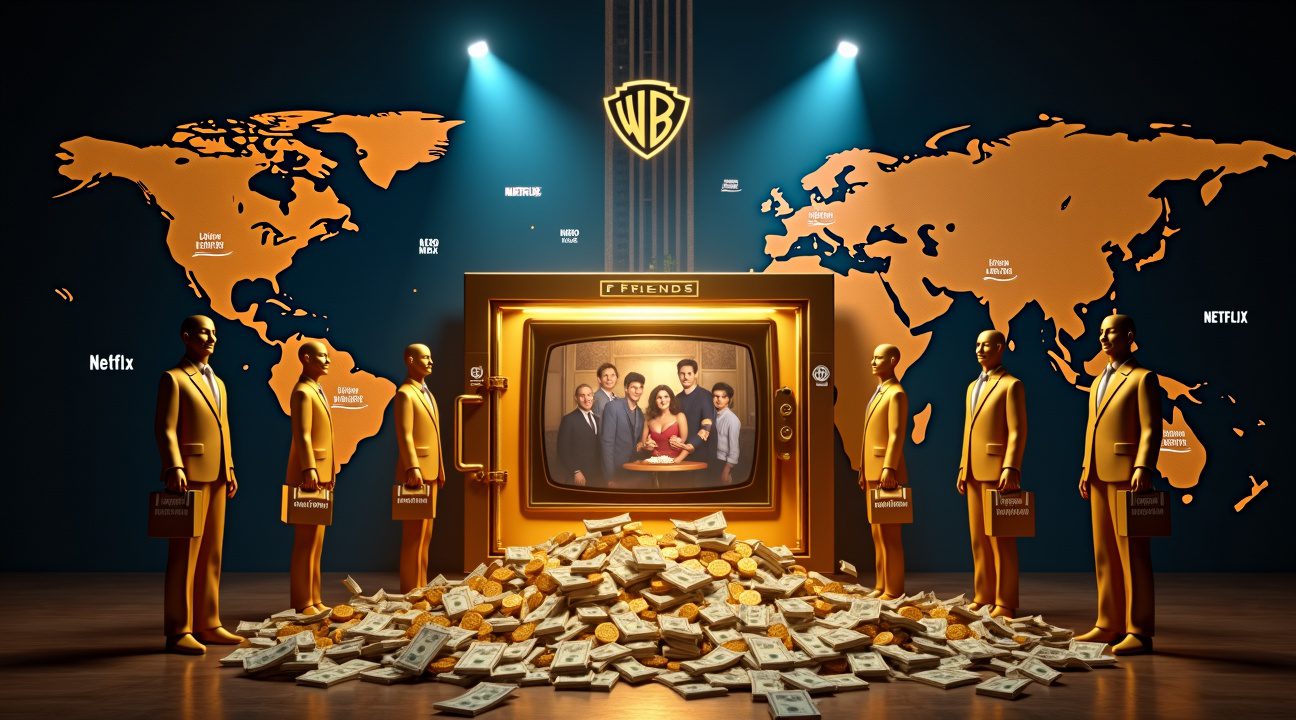The six main cast members of Friends continue to earn approximately $20 million each year from reruns, nearly two decades after the show concluded in 2004.
Key Takeaways
- Each Friends cast member earns about $20 million annually from reruns due to a 2% share of syndication revenue they negotiated during the show’s original run.
- Warner Bros. generates roughly $1 billion each year through Friends syndication across global markets, streaming platforms, and traditional TV.
- The cast leveraged collective bargaining to raise their per-episode salary from $22,500 in season one to $1 million by the final seasons.
- Streaming platforms invested heavily for viewing rights: HBO Max secured a five-year deal for $425 million, while Netflix previously paid $100 million annually.
- The Friends reunion on HBO Max brought in additional earnings of approximately $2.5 to $3 million per cast member, proving the show’s lasting appeal and profitability.
Friends Cast Members Each Earn $20 Million Annually From Reruns Two Decades Later
The financial legacy of Friends continues to astound industry observers two decades after the show ended its original run. Each of the six main cast members still collects approximately $20 million annually from reruns, creating one of television’s most impressive residual income streams. This remarkable earning power stems from the exceptional syndication deal the actors negotiated during the show’s peak popularity.
The Lucrative Syndication Deal Behind the Earnings
Jennifer Aniston, Courteney Cox, Lisa Kudrow, Matt LeBlanc, Matthew Perry, and David Schwimmer each secured a 2% share of the syndication revenue through their original contracts. This arrangement has proven incredibly valuable as Warner Bros. generates approximately $1 billion annually from Friends syndication across various platforms and networks worldwide. The deal represents a masterclass in long-term financial planning, as the cast members recognized the potential for ongoing revenue well beyond the show’s original airing.
The syndication model allows networks and streaming platforms to purchase rights to air reruns, creating a continuous revenue stream that benefits both the production company and the talent. Friends cast members make millions annually because their show maintains exceptional viewership numbers across multiple demographics and international markets.
Sustained Popularity Drives Continued Financial Success
The show’s enduring appeal has defied industry expectations about the typical lifecycle of television content. Friends maintains strong ratings on cable networks, streaming services, and international broadcasts, contributing directly to the cast’s ongoing compensation. The series has found new audiences through platforms like Netflix, HBO Max, and traditional syndication deals with networks worldwide.
Several factors contribute to this sustained popularity:
- Universal themes of friendship, relationships, and career challenges
- Appeal across generations and cultural boundaries
- Strong international performance with dubbed and subtitled versions
This global appeal significantly amplifies the syndication revenue that flows back to the cast members.
The financial success also reflects the show’s strategic positioning in the entertainment landscape. The cast receives massive royalties from reruns because Warner Bros. has effectively maximized distribution opportunities across traditional television, streaming platforms, and international licensing deals.
This residual income structure has established a new benchmark for television talent negotiations. The Friends deal demonstrates how performers can secure long-term financial benefits from successful shows, influencing how contracts are structured in the modern entertainment industry. The arrangement also highlights the importance of recognizing a show’s potential longevity during initial contract negotiations.
The $20 million annual earnings per cast member represent more than just individual financial success. These figures illustrate how exceptional television content can generate value for decades after production ends. Friends cast members make substantial amounts from syndication because they participated in creating content that transcends typical entertainment boundaries.
The ongoing success of Friends syndication revenue proves that quality television programming can function as a long-term investment vehicle. The show’s ability to generate $1 billion annually for Warner Bros. while providing substantial compensation to its cast members creates a win-win scenario that continues to influence industry practices and contract negotiations across the entertainment sector.
https://www.youtube.com/watch?v=hDNNmeeJs1Q
How Warner Bros Makes $1 Billion Annually From Friends Syndication
Warner Bros has turned Friends into a financial goldmine, generating an astounding $1 billion annually from syndication revenue across multiple platforms. This massive revenue stream stems from the show’s incredible staying power and strategic distribution deals that span traditional television, international markets, and modern streaming platforms.
The Revenue Breakdown Behind the Billion-Dollar Empire
The studio’s syndication strategy operates across several key revenue channels:
- Traditional television reruns form the foundation of this income, with local stations and cable networks paying substantial licensing fees to broadcast episodes.
- International distribution deals contribute significantly to the total, as Friends maintains popularity in markets worldwide.
- Streaming platform licensing agreements add another lucrative layer, with services paying premium rates for exclusive or non-exclusive rights to the series.
Syndication earnings work on a percentage-based model that benefits both the studio and the cast. The six main cast members negotiated a remarkable 2% share of the syndication revenue pool during their final contract negotiations. This seemingly small percentage translates into approximately $20 million per cast member annually when applied to Warner Bros’ billion-dollar syndication income.
Why Friends Continues to Drive Massive Viewership
The show’s enduring appeal transcends generational boundaries, attracting both original fans and new viewers discovering the series for the first time. Nielsen data consistently shows Friends ranking among the top-performing syndicated series, often outperforming many current primetime shows in key demographics. This sustained popularity allows Warner Bros to command premium pricing from networks and streaming services competing for content that guarantees audience engagement.
International markets contribute substantially to the revenue totals, with Friends maintaining strong viewership in countries across Europe, Asia, and Latin America. The universal themes of friendship, romance, and humor translate effectively across cultures, making it a valuable export for the studio. These global licensing deals often include multi-year agreements worth hundreds of millions of dollars.
Streaming platforms have intensified competition for Friends content, driving licensing fees even higher. The series has proven that classic sitcoms can generate subscriber acquisition and retention for streaming services, making it an essential asset in their content libraries. Friends cast members benefit directly from this competitive marketplace, as increased licensing values directly impact their syndication percentages.
Warner Bros’ billion-dollar annual revenue from Friends syndication demonstrates how strategic content distribution can create long-term financial success. The combination of widespread appeal, smart licensing strategies, and percentage-based profit sharing has created a sustainable income model that continues paying dividends decades after the show’s original run ended.

Streaming Platforms Pay Massive Sums to Keep Friends
Streaming services have transformed how television content reaches audiences, and Friends stands as a prime example of this digital gold rush. I’ve observed how these platforms engage in bidding wars for popular content, with Friends commanding some of the highest prices in streaming history.
Record-Breaking Licensing Deals
Netflix initially secured Friends for a modest $30 million, recognizing the show’s potential to drive subscriber engagement. However, as the series proved its worth through consistent viewership numbers, the streaming giant increased its investment dramatically. The platform eventually paid $100 million annually to maintain the show’s presence in its catalog, demonstrating just how valuable the series had become for subscriber retention and acquisition.
HBO Max then entered the picture with an unprecedented offer. The WarnerMedia-owned platform secured exclusive streaming rights through a deal worth $425 million over five years. This astronomical figure reflects not just the show’s popularity but also its strategic importance in HBO Max’s launch strategy. Friends cast members benefit significantly from these massive platform investments, as their syndication agreements tie their earnings directly to the show’s continued success across all distribution channels.
Enhanced Viewership Creates Revenue Multiplication
Streaming availability has created a renaissance for Friends, introducing the series to entirely new generations while satisfying nostalgic viewers who grew up with the show. I notice that platforms like Netflix and HBO Max have made the series more accessible than traditional television reruns, allowing viewers to binge entire seasons and discover episodes they might have missed during the original broadcast run.
This enhanced accessibility directly impacts syndication revenue calculations. When streaming platforms report higher engagement metrics for Friends, it strengthens the show’s position in future licensing negotiations. Television networks and international broadcasters see these streaming success stories and recognize that Friends remains a valuable asset for their own programming schedules.
The streaming boom has also created a competitive environment where multiple platforms vie for content that guarantees viewer engagement. Friends fits this criteria perfectly, as its episodic nature and universal themes make it ideal for repeat viewing. Each platform that licenses the show contributes to the overall revenue pool that eventually flows back to the cast through their syndication agreements.
International streaming services have joined this competition as well. Netflix’s global reach meant that Friends gained new audiences in countries where it hadn’t previously achieved significant popularity. These international licensing deals add another layer to the revenue structure that benefits all parties involved in the original production.
Warner Bros., which owns the distribution rights, has leveraged this streaming demand to maximize profits from their most valuable television asset. The studio’s ability to command such high licensing fees from streaming platforms creates a larger pool of syndication revenue. Since syndication payments flow directly to cast members, these streaming deals have effectively multiplied their annual earnings from the show.
The timing of these streaming deals has proven particularly fortuitous for the Friends cast. As traditional television viewership declined, streaming platforms emerged as new revenue streams that often exceeded the profits from conventional syndication. HBO Max’s decision to make Friends a cornerstone of their service launch strategy exemplifies how streaming platforms view certain content as essential rather than optional.
This streaming-driven revenue model has created a sustainable income stream that shows no signs of diminishing. Unlike traditional syndication, which can vary based on time slots and regional popularity, streaming platforms typically sign multi-year deals with guaranteed minimum payments. These agreements provide the cast with more predictable income projections and have contributed significantly to their substantial annual earnings from reruns.
The success of Friends on streaming platforms has also influenced how other classic television shows negotiate their digital distribution rights, setting new precedents for what constitutes fair compensation in the streaming era.
From $22,500 to $1 Million Per Episode During the Original Run
The Friends cast transformed their earnings from modest beginnings to television’s highest-paid performers through strategic salary negotiations. Each actor started with $22,500 per episode during the first season, a standard rate for unknown actors on a new sitcom. However, their collective approach to contract negotiations would revolutionize how television actors handle salary discussions.
Rather than negotiating individually, the six cast members made a bold decision to negotiate as a group. This strategy ensured equal pay for all main characters and created unprecedented leverage against the network. Jennifer Aniston, Courteney Cox, Lisa Kudrow, Matt LeBlanc, Matthew Perry, and David Schwimmer recognized their collective value and refused to accept different salary levels.
Salary Progression Through the Seasons
Their unified approach paid off dramatically as ratings soared and the show became a cultural phenomenon. By the middle seasons, each cast member earned approximately $100,000 per episode. The real breakthrough came during contract renegotiations for the final two seasons, where they successfully demanded $1 million per episode each.
This salary progression represents one of television’s most successful collective bargaining strategies. The cast’s decision to stand together prevented the studio from playing favorites or creating divisions within the group. Their approach demonstrated that ensemble casts could wield significant power when they presented a united front.
The total earnings from the original series exceeded $90 million per cast member when combining base salaries with bonuses and other contractual benefits. These figures don’t include the substantial backend deals that continue generating revenue today. The cast negotiated syndication points that ensure they profit from the show’s ongoing success in reruns and streaming platforms.
Their collective bargaining strategy established a new precedent for television contracts, particularly for ensemble shows. Future series would adopt similar approaches, recognizing that unified cast negotiations could benefit everyone involved. The Friends model proved that actors didn’t need to compete against each other for higher salaries.
The financial success extends far beyond the original run, as Friends cast members continue earning substantial amounts from syndication deals negotiated during their original contracts. These backend arrangements ensure that each performer benefits from the show’s enduring popularity across multiple platforms and international markets.
The Friends salary evolution demonstrates how strategic thinking and collective action can transform modest television wages into generational wealth. Their approach changed industry standards and showed that successful ensemble casts could command unprecedented compensation when they worked together rather than against each other.

Friends Reunion Special Brought Additional Millions
The Friends reunion special on HBO Max delivered another substantial payday for the cast, with each member earning between $2.5 million and $3 million for their appearance. This one-time payment added a significant boost to the already impressive annual earnings that Friends cast members continue to receive from syndication deals worldwide.
The Power of Nostalgia in Entertainment
The reunion special proved that the cultural impact of Friends extends far beyond its original ten-season run. Fans around the globe eagerly anticipated seeing Jennifer Aniston, Courteney Cox, Lisa Kudrow, Matt LeBlanc, Matthew Perry, and David Schwimmer together again on the iconic sets. The special generated massive viewership numbers for HBO Max and demonstrated how classic television content continues to drive subscriber engagement for streaming platforms.
Networks and streaming services recognize the value of established franchises, particularly when they carry the emotional weight that Friends does for multiple generations of viewers. The reunion format allowed the cast to revisit their most memorable moments while sharing behind-the-scenes stories that fans had never heard before. This approach created fresh content from beloved material, maximizing the return on investment for both the platform and the performers.
Global Popularity Drives Continued Success
Friends maintains its position as one of the most popular television series globally, with new audiences discovering the show through various streaming platforms. The series continues to attract viewers who weren’t even born when it originally aired, proving its timeless appeal and universal themes of friendship, love, and personal growth.
International markets contribute significantly to the show’s ongoing success, with syndication deals spanning multiple countries and languages. The show’s humor translates across cultures, and its portrayal of young adult life in New York City resonates with audiences worldwide. This global reach ensures that syndication revenues remain strong, supporting the cast’s annual earnings from reruns.
The reunion special served as a catalyst for renewed interest in the original series. Streaming platforms reported increased viewership of Friends episodes following the special’s release, creating a positive feedback loop that benefits both the platforms and the cast members who receive residual payments. The special also introduced the show to viewers who might have been curious about the cultural phenomenon but hadn’t yet watched the series.
Production companies continue to invest in Friends-related content because the brand carries minimal risk and virtually guaranteed returns. The reunion special’s success confirmed that audiences remain deeply connected to these characters and the world they inhabited. The massive royalties from reruns demonstrate how smart negotiations and profit-sharing agreements can create long-term wealth for performers.
The special also highlighted how the entertainment industry has evolved since Friends concluded in 2004. Streaming platforms now compete for classic content that can anchor their libraries and attract subscribers. The reunion format provides a way to monetize beloved properties without creating entirely new content, reducing production risks while capitalizing on established fan bases.
Each cast member’s $2.5 to $3 million payday for the reunion special represents just a fraction of their annual earnings from the original series. However, it demonstrates how valuable their association with the Friends brand remains nearly two decades after the show ended. The special reinforced their positions as entertainment industry icons whose mere presence can drive significant viewership and revenue.
The enduring success of Friends proves that quality television content can generate income for decades when properly managed and distributed. The reunion special added another chapter to this success story, showing how classic entertainment properties can be refreshed and monetized for new platforms and audiences while respecting the original material that made them special.
https://www.youtube.com/watch?v=HRXVQ77ehRQ

Sources:
SlashFilm: “How Much The Friends Cast Makes From Reruns”
LADBible: “Huge amount Friends cast earn each year from reruns of the show”
BrandVM: “How Much Did the Friends Cast Make Per Episode? The Salaries …”
IMDb: “Cast Of Friends Continues To Earn $20 Million A Year—The Power of Reruns Explained”
Koimoi: “Cast Of Friends Continues To Earn $20 Million A Year – Koimoi”
Telegrafi: “How much the stars of ‘Friends’ earn from the millions series every year”


